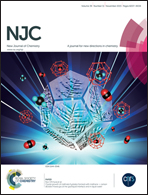ESIPT and CHEF based highly sensitive and selective ratiometric sensor for Al3+ with imaging in human blood cells†
Abstract
Based on excited state intramolecular proton transfer (ESIPT) and chelation enhanced fluorescence (CHEF) mechanisms, a new fluorescence ratiometric probe for Al3+ was designed and synthesized, and its structure was confirmed through single crystal X-ray study. This probe is capable of showing excited state intramolecular proton transfer through two different pathways. The introduction of Al3+ in a mixed aqueous solution with the probe results in an abrupt change in the photophysical properties of the probe. A ratiometric emission profile was observed in the presence of Al3+. Interestingly, the presence of other metal ions (especially trivalent ions, e.g. Fe3+, Cr3+, Ga3+ and In3+) do not perturb the fluorescence intensity of the probe (except Cu2+ and Pb2+, where slight changes were noticed). This indicates that the probe shows high affinity towards Al3+. The ratiometric sensing phenomenon may be explained by the presence of two different mechanisms, namely, excited state intramolecular proton transfer and chelation induced enhanced fluorescence, which are demonstrated by the probe in presence of Al3+ in the excited state. The complexation of the probe with Al3+ inhibits excited state intramolecular proton transfer while the chelation induced enhanced fluorescence mechanism becomes dominant. The probe efficiently detected the cellular uptake of Al3+, which is demonstrated here with human blood-cell imaging. Moreover, the detection limit was found to be 6.72 × 10−8 M.


 Please wait while we load your content...
Please wait while we load your content...